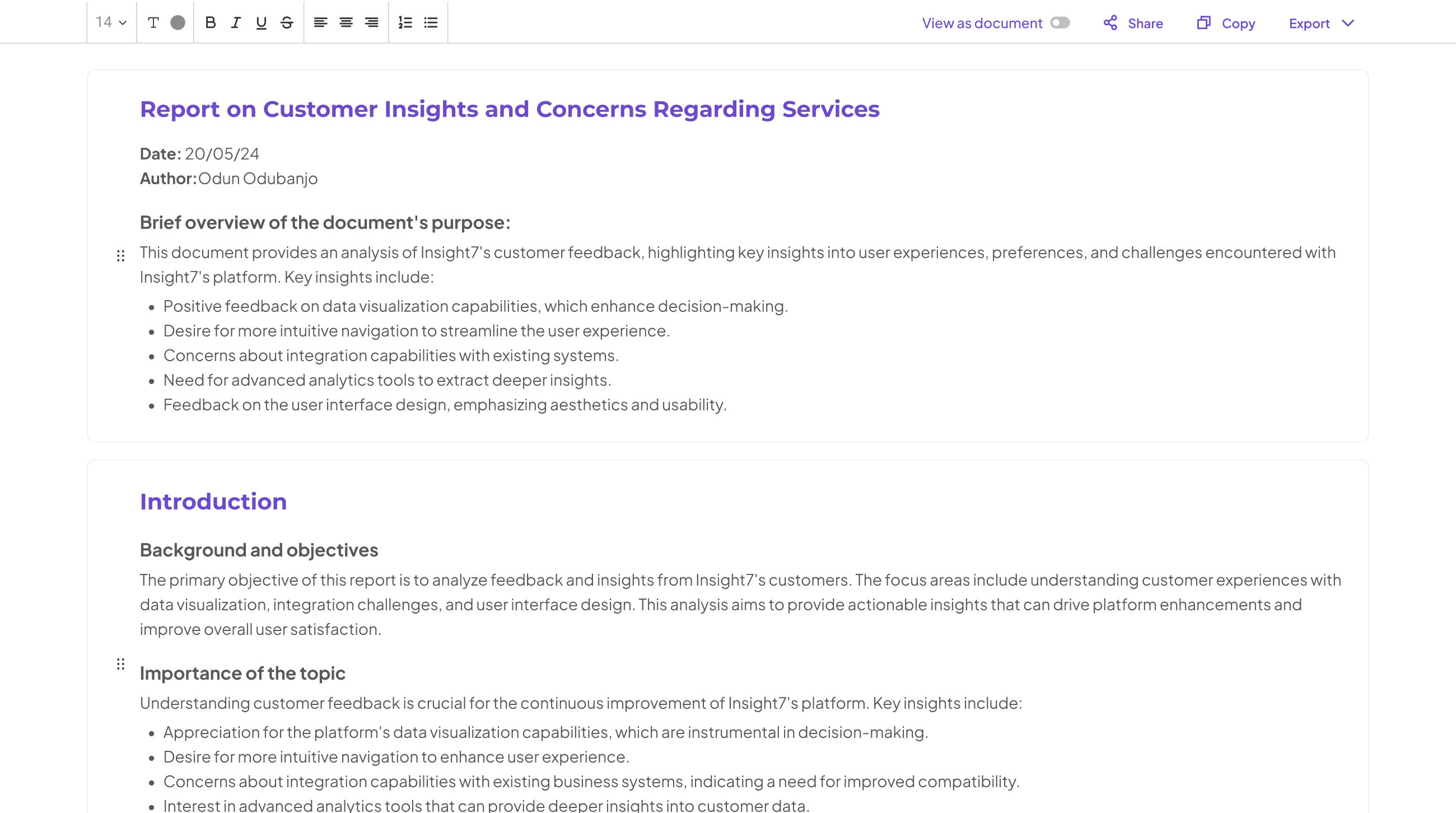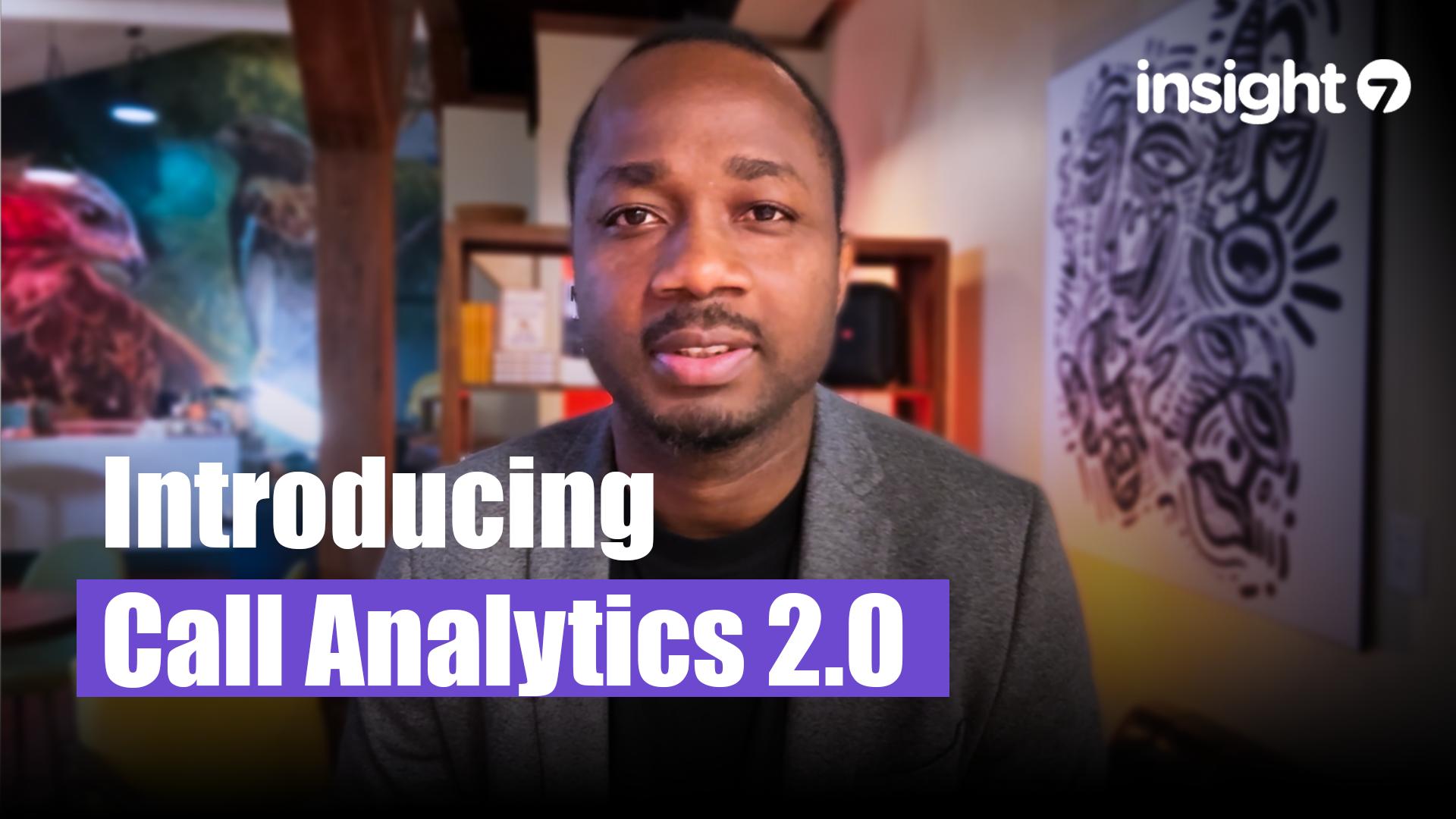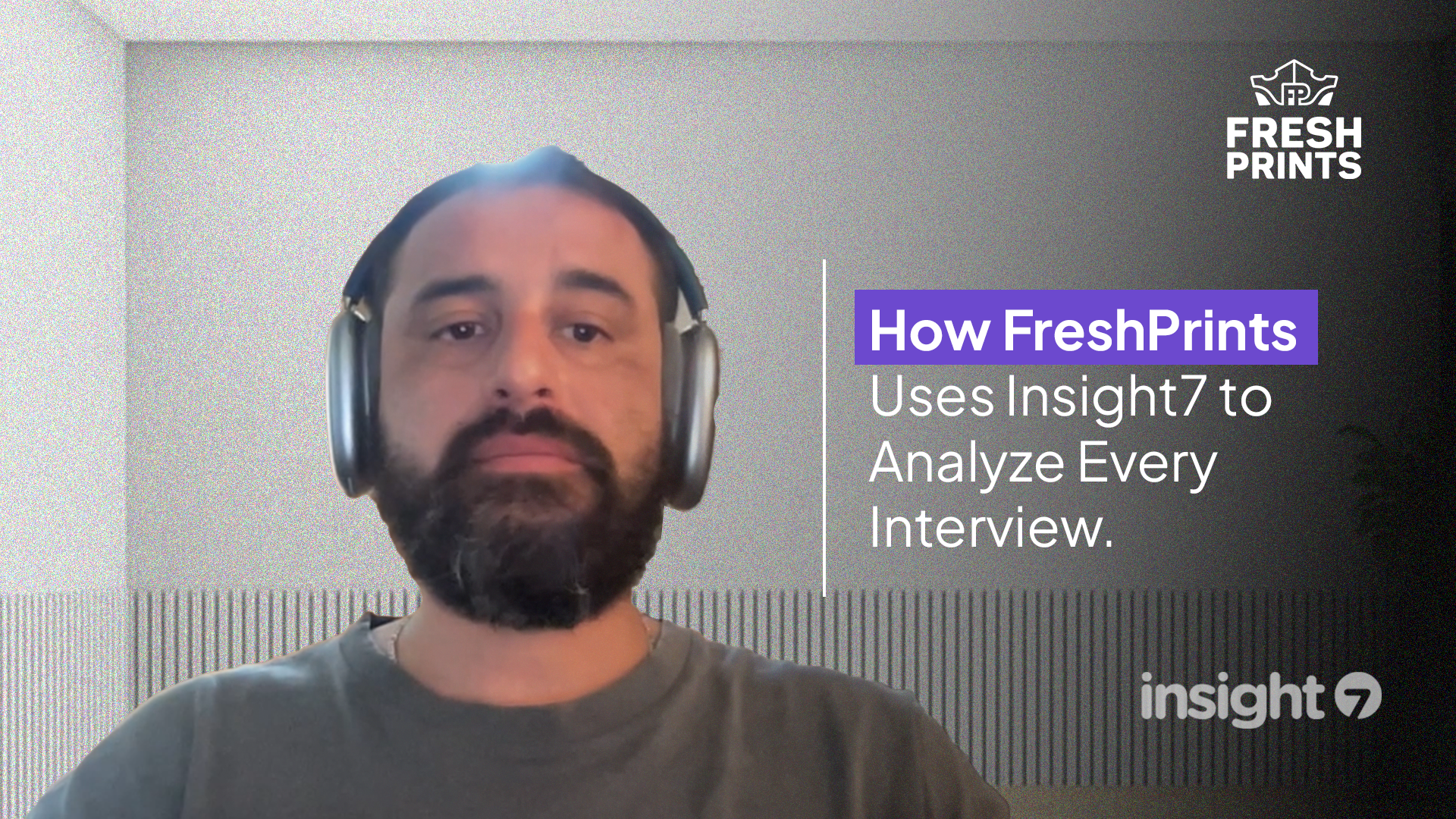Best AI tools for visualizing reports from transcripts
-
Bella Williams
- 10 min read
The realm of data analysis is rapidly evolving, particularly with the advent of transcript visualization tools. These tools transform raw transcript data into meaningful visual representations, effectively streamlining the process of extracting insights from conversations. Whether you're transcribing customer interviews or team meetings, the ability to visualize information helps uncover crucial trends and insights that may otherwise go unnoticed.
Understanding the potential of these tools is pivotal for businesses facing an ever-increasing amount of interaction data. By utilizing advanced AI technology, transcript visualization tools simplify the analysis process, allowing users to identify themes, pain points, and actionable insights quickly. This capability not only saves time but also enhances decision-making processes, making organizations more agile in their responses to customer needs.
Transcribe & extract insights from interviews. At Scale.

The Need for Transcript Visualization Tools
Transcripts can often become overwhelming when dealing with large amounts of data. This is where the need for Transcript Visualization Tools arises. These tools transform lengthy text into engaging visuals, making it easier to comprehend and derive insights. By converting transcripts into diagrams, word clouds, or summary tables, users can quickly identify essential themes and patterns without getting bogged down by excessive text.
Furthermore, effective visualization enhances collaboration among team members. Stakeholders can discuss shared insights and extract actionable information more efficiently. It supports decision-making processes by providing a clear visual representation of key points, pain areas, and opportunities highlighted in discussions. In today’s data-driven world, employing Transcript Visualization Tools is essential for organizations aiming to unlock deeper insights, drive strategic decisions, and enhance overall productivity.
Understanding the Basics of Transcript Visualization
Transcript visualization is an essential process that transforms raw dialogue into meaningful insights. This technique helps users analyze conversations efficiently, making it easier to extract valuable data from various sources like interviews, meetings, and focus groups. Transcript visualization tools streamline this process by converting spoken words into structured formats that highlight important themes and sentiments.
The primary function of these tools is to enable users to visualize data from transcripts meaningfully. They offer features such as keyword extraction, sentiment analysis, and the ability to isolate key points from lengthy discussions. By employing these tools, organizations can quickly identify patterns, make informed decisions, and generate comprehensive reports. Understanding the basics of transcript visualization sets the foundation for utilizing advanced AI tools effectively, allowing businesses to enhance their analytical capabilities and improve strategic outcomes.
Benefits of Using AI in Transcript Visualization
Using AI in transcript visualization offers several advantages that transform how insights are extracted from conversations. First and foremost, these tools automate the tedious process of transcription and analysis, enabling users to focus on extracting valuable insights rather than getting bogged down in logistics. The integration of AI ensures that large volumes of data, such as recorded conversations, can be processed rapidly, making it easier to visualize trends and patterns.
Another key benefit is the enhanced accuracy and efficiency that AI brings to the analysis. By employing natural language processing techniques, transcript visualization tools can quickly identify key themes and sentiments within conversations. This allows businesses and researchers to gain a clearer understanding of customer needs and pain points. Ultimately, the use of AI in these tools streamlines the reporting process, empowering users to make more informed decisions based on well-visualized data. These strategic advantages highlight the significance of adopting AI-powered resources in transcript visualization efforts.
Generate Detailed Reports from Your Qualitative Data in Minutes.
Top Transcript Visualization Tools for Report Generation
Effective report generation is significantly enhanced by utilizing top transcript visualization tools. These tools simplify the process of converting raw transcripts into visually appealing and insightful reports. They empower users to analyze data seamlessly, extracting meaningful insights from conversations or meetings quickly. By leveraging advanced AI technologies, these tools can automatically transcribe audio and video files, making the data accessible for further analysis.
Some notable transcript visualization tools include Otter.ai, which excels in automated transcript management, and Descript, which offers multimedia capabilities that extend beyond simple text. Trint provides seamless integration with other platforms, while Sonix enables real-time collaboration and sharing, enhancing team productivity. These tools collectively improve the efficiency of report generation, making it easier than ever to identify trends, gather insights, and produce comprehensive reports from transcripts.
Insight7: Leading the Way in AI-Powered Visualizations
AI-powered visualizations are revolutionizing how we approach data analysis and report generation. Companies increasingly rely on Transcript Visualization Tools to convert raw conversation data into actionable insights. These tools enable users to visualize trends, patterns, and essential data points, significantly enhancing decision-making capabilities.
To understand the impact of AI in this field, we can consider several key aspects. First, automation streamlines the processing of large volumes of transcript data, reducing the time it takes to generate reports. Second, advanced algorithms analyze customer interactions and highlight critical insights, fostering a more responsive business approach. Lastly, collaborative features allow teams to work together more efficiently, ensuring that valuable insights are not lost or overlooked. By embracing these approaches, businesses can maintain a competitive edge in an increasingly data-driven marketplace.
Other Powerful Tools for Visualizing Transcripts
There are several other powerful tools available that cater specifically to transcript visualization needs. Tools like Otter.ai offer automated transcript management, making it easy to capture and visualize conversations without manual input. With its user-friendly interface, users can quickly generate and access their transcripts for analysis.
Descript goes beyond mere text by incorporating multimedia capabilities, allowing users to edit audio and video along with text. This feature provides a comprehensive view of the conversation, making it easier to extract insights. Trint, on the other hand, focuses on seamless integration with other platforms, facilitating an efficient workflow that enhances productivity. Lastly, Sonix provides an environment for real-time collaboration and sharing, enabling teams to work together on transcripts and insights. Each of these transcript visualization tools plays a unique role in maximizing the potential of transcript data, offering various features tailored to different user needs.
- Otter.ai: Automated Transcript Management
Transcribing conversations efficiently is a cornerstone of effective transcript management. With automation capabilities, users can upload multiple audio files for quick transcription, simplifying the process significantly. By utilizing automated transcript management, businesses can ensure that they capture key insights from their conversations. This streamlining of data collection is vital for comprehensively analyzing discussions and enhancing decision-making.
Moreover, managing automated transcripts allows for easy retrieval and analysis of specific insights. Users can filter, summarize, and visualize key themes easily from their transcripts. This functionality enables teams to identify customer pain points and extract evidence-backed insights effortlessly. Integrating such transcript management tools enhances overall productivity, turning raw data into actionable strategies. Through these automated capabilities, organizations can visualize important data trends effectively, ultimately transforming how they approach and utilize conversation-based information.
- Descript: Beyond Text with Multimedia Capabilities
Visualizing transcripts goes beyond mere text; it encompasses audio and visual elements that enhance understanding and engagement. This tool offers a robust platform where users can easily manage and interpret information from multiple calls or meetings. The versatility it provides ensures that anyone, regardless of technical expertise, can access and utilize vital data insights efficiently.
Key features include an intuitive library where files are stored and managed. It allows users to transcribe various content easily, analyzing each conversation for crucial insights, such as pain points and customer desires. With the ability to extract evidence from discussions, users can create tailored reports. Moreover, it supports collaborative projects, enabling the analysis of numerous calls simultaneously. These multimedia capabilities facilitate a richer experience of transcript visualization tools, transforming how businesses derive actionable insights from interactions.
- Trint: Seamless Integration with Other Platforms
Integrating seamlessly with various platforms is a game changer for transcript visualization tools. Users can effortlessly connect their tools with popular applications, enhancing the overall usability and accessibility of insights. This fluid integration enables users to import data from different sources quickly, allowing for a streamlined process in analyzing and visualizing transcripts.
Moreover, synchronization with collaboration platforms ensures that members of a team can work together in real-time. This collaboration enhances the quality of the reports generated from transcripts, as multiple viewpoints contribute to the insights. Users can expect reduced friction during workflow transitions, making it easier to gather and visualize data effectively. The ability to pull data from diverse platforms not only enriches the analysis process but also greatly improves the efficiency of report generation. By ensuring that the tool works harmoniously with existing software, businesses can maximize their productivity and insight-driven decision-making.
- Sonix: Real-time Collaboration and Sharing
Real-time collaboration and sharing are vital features of modern transcript visualization tools. These capabilities streamline workflows, enabling teams to seamlessly access and edit shared files for improved productivity. Such tools allow multiple users to analyze transcriptions simultaneously, which enhances communication and decision-making processes. This collaborative nature ensures that insights drawn from transcripts are not limited to a single user, promoting a collective understanding among all stakeholders involved.
In addition to collaboration, these tools often include intuitive interfaces that make it easy for teams to visualize data from transcripts. By employing features such as keyword summaries and categorized insights, users can quickly locate essential information. Furthermore, the ability to question and extract themes from transcripts fosters a dynamic environment where continuous learning and adaptability are prioritized. These elements collectively enhance the effectiveness of transcript visualization tools, making them indispensable resources for any data-driven organization.
Conclusion on Transcript Visualization Tools
Transcript Visualization Tools have transformed how we interpret data from conversations. These tools streamline the process of turning audio recordings into actionable insights with remarkable ease. Users can upload multiple files simultaneously, allowing for bulk analysis that saves time and increases productivity. Once transcribed, the data can be mined for specific insights, such as identifying customer pain points or summarizing conversations, ensuring that critical information is easily accessible.
As organizations increasingly rely on data-driven decisions, the importance of effective Transcript Visualization Tools cannot be overstated. They empower users to derive meaning from conversations effortlessly, enhancing overall understanding and engagement. By utilizing these tools, teams can foster better communication, streamline workflows, and ultimately drive more informed strategies to meet their objectives.







